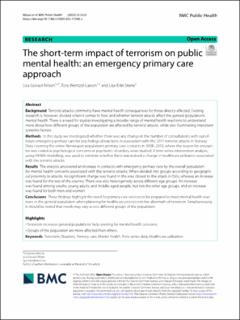| dc.description.abstract | Background
Terrorist attacks commonly have mental health consequences for those directly affected. Existing research is, however, divided when it comes to how and whether terrorist attacks affect the general population’s mental health. There is a need for studies investigating a broader range of mental health reactions to understand more about how different groups of the population are affected by terrorist attacks, while also illuminating important systemic factors.
Methods
In this study we investigated whether there was any change in the number of consultations with out-of-hours emergency primary care for psychological reactions in association with the 2011 terrorist attacks in Norway. Data covering the entire Norwegian population’s primary care contacts in 2008–2013, where the reason for encounter was coded as psychological concerns or psychiatric disorders, were studied. A time series intervention analysis, using ARIMA modelling, was used to estimate whether there was indeed a change in healthcare utilisation associated with the terrorist attacks.
Results
The analysis uncovered an increase in contacts with emergency primary care by the overall population for mental health concerns associated with the terrorist attacks. When divided into groups according to geographical proximity to attacks, no significant change was found in the area closest to the attack in Oslo, whereas an increase was found for the rest of the country. There was also heterogeneity across different age groups. An increase was found among youths, young adults, and middle-aged people, but not the other age groups, and an increase was found for both men and women.
Conclusions
These findings highlight the need for primary care services to be prepared to meet mental health reactions in the general population when planning for healthcare provision in the aftermath of terrorism. Simultaneously, it should be noted that needs may vary across different groups of the population. | en_US |

